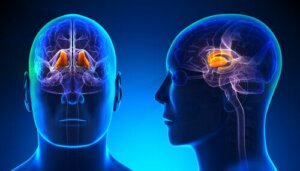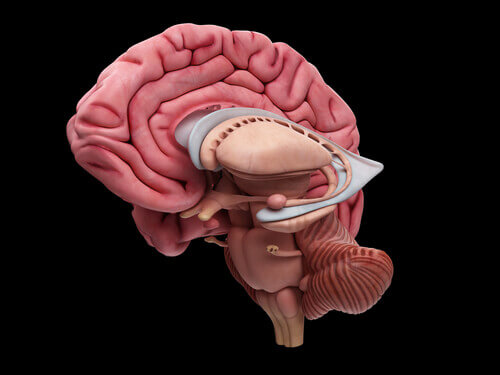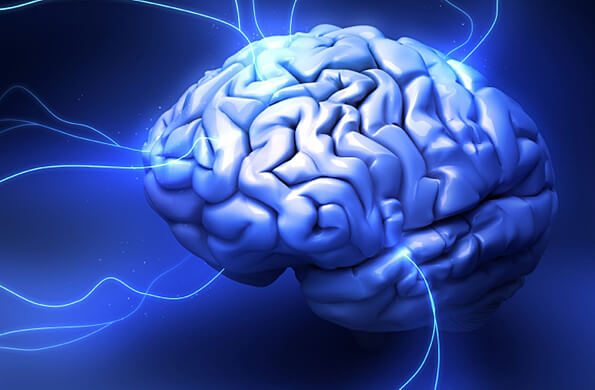The Characteristics and Functions of the Thalamus


Written and verified by the psychologist Gema Sánchez Cuevas
The thalamus is an oval-shaped structure that constitutes the dorsal portion of the diencephalon. It transmits sensory input to the primary sensory zones of the cortex. However, it’s more than just a relay station.
The main function of the thalamus is the integration of sensory information directed to the cortex. In fact, it transmits most of the information that reaches the cerebral cortex. In addition, it integrates various sensory modalities. It also facilitates or inhibits projections towards certain lobes.
The thalamus is essential for the maintenance of cortical activity. Furthermore, it’s responsible for transmitting information from the cerebellum and the striatum to the cerebral cortex. The cerebellum and striatum are centers that modulate the descending motor pathways of the cerebral cortex. As a matter of fact, almost all sensorimotor information passes through the thalamus before reaching its destination (cortex).
The thalamus is organized into different nuclei with different functions. The only sensory information that doesn’t originate from the thalamus is olfactory information. This passes directly from the olfactory bulb to the cerebral cortex. However, the rest of the senses: taste, vision, touch, and hearing are released in the nuclei of the thalamus. They’re then projected to their own corresponding areas in the cortex.
The thalamus also deals with descending information. In other words, the information that the cortex sends to other regions. Its main function is to regulate sensorimotor projections. However, it’s also involved in the functioning of some higher processes. For example, memory or language.
The make-up of the thalamus

The thalamus is part of the diencephalon located at the base of the brain, between the telencephalon and the brain stem. In addition to the thalamus, three other subdivisions form part of the diencephalon. These are the hypothalamus, the subthalamus, and the epithalamus. The thalamus is the largest of the four subdivisions. It consists of groups of neurons that project to all areas of the cerebral cortex.
Virtually all information arriving or descending from the cortex first passes through the thalamus. The nuclei of the thalamus are organized around the medullary lamina. This is shaped like a ‘Y’. It divides the thalamus into three parts: anterior, medial, and lateral.
Regarding the role played by each of the nuclei, we can classify them into:
- Thalamic relay nuclei. These are intermediate processing stations in the sensory transit to the cerebral cortex. They send their projections to specific areas of the cortex
- Diffuse projection. These are nonspecific. They don’t send projections to specific areas.
- Association nuclei. They form part of a circuit that connects the cerebral cortex with subcortical structures.
Thalamic-cortical connections
Communication between the cortex and the thalamus is reciprocal and bidirectional. The thalamus consists of projection neurons that aim to communicate with other areas. For example, the cortex, cerebellum, or basal ganglia. In addition, it also has interneurons that send information between the nuclei of the thalamus. Thus, the relay nuclei send projections to specific areas of the cortex.
Each sensory modality has its own relay nucleus, except for the sense of smell. Sensory relay nuclei transmit their signals to specific areas of the cortex located in the parietal, occipital, temporal, and insula lobes. In addition, each sensory relay thalamic nucleus receives projections from the brain area to which it projects.
Those with diffuse projection include the intralaminar group, the midline group, and the reticular group. The first two are characterized by the fact that information from different areas of the brain and spinal cord converges on them. In turn, they distribute it to large areas of the cerebral cortex, without respecting the limits of the cortical areas.
The thalamus functions as a station that processes and transmits the signals it receives to the cerebral cortex. However, it also acts as a center that controls the signals that reach it. The reticular nucleus carries out this function of controlling cortical activity. Furthermore, the function of the thalamus is crucial for the functioning of our central nervous system (CNS). In fact, any damage to it would lead to various deficits.

Groups of relay and diffuse projection nuclei
Up to 50 nuclei have been identified. They’re usually classified into four groups with respect to the internal medullary lamina (fiber bundle):
- Anterior. They participate in memory and emotions. They’re connected with regions of the cingulate and frontal cortex.
- Medial. These are three subdivisions. Each of them is connected to a specific region of the frontal cortex. They receive input from the basal ganglia, the tonsillar nucleus, and the midbrain. Furthermore, they’re also involved with memory.
- Ventral. These are important for motor control. They transmit information from the cerebellum and basal ganglia to the motor cortex.
- Posterior. These consist of the medial geniculate, lateral geniculate, and pulvinar. The medial geniculate is a component of the auditory system. It transmits tonotopically organized auditory information to the temporal lobe. The lateral geniculate receives information from the retina. It sends the visual information to the primary visual cortex of the occipital lobe. Finally, the pulvinar projects to areas of the parietal-occipital-temporal association. This is more developed in humans.
As for the diffuse projection nuclei, they’re located in the midline of the thalamus or in the medullary lamina. The intralaminar nuclei project to limbic structures. These govern the activation of the cortex. They may also participate in the integration of sensory submodalities. The reticular nucleus regulates the activity of other thalamic nuclei based on their control.
However, the thalamus isn’t only a simple relay station to transfer to the neocortex. As a matter of fact, it’s a complex brain region where a substantial degree of information processing is possible. Indeed, it acts as a guardian of information to the cerebral cortex. Furthermore, it prevents or facilitates the passage of specific information depending on the individual’s state of consciousness.
The many functions of the thalamus
The thalamus is a complex structure that has implications in various functions of the central nervous system. Here are some of them:
- Sensitive motor. It’s responsible for the analysis and integration of sensitive functions. These can be mechanical, thermal, and painful stimuli. Any damage to this area can cause sensory loss contralateral to the injury, paresthesia, or thalamic pain. In addition, at the motor level, it’s involved in voluntary and involuntary movements and gait.
- Attention. Evidence has been found regarding its involvement in the sleep-wake cycle and in the degree of consciousness.
- Emotions. It’s responsible for the integration of visceral information with affection, emotions, and thought.
- Language. Mainly, it influences the motor aspects of language. In fact, damage to the thalamus can cause naming or syntactic problems.
- Memory. There’s a clear involvement of the thalamus in anterograde memory. In other words, the formation of new memories. In addition, it collaborates in the temporary organization of recent and ancient memories. Any damage is related to diseases characterized by amnesia. For instance, in disorders such as Korsakoff syndrome.
- Executive function. In its projections to the prefrontal cortex, it modulates executive functions, attention, initiative, inhibition, and the temporal organization of behavior.
As you can see, the role of the thalamus isn’t limited to a single function. Indeed, it modulates multiple sensory, motor, and even higher functions.
Therefore, it can be stated that the thalamus plays an important role in different brain functions. These include memory, emotions, the sleep-wake cycle, and executive functions. Furthermore, it’s also involved in cortical responses of alertness, sensorimotor control, and the processing of sensory information.
Injury to the thalamus

The thalamus is a gray nucleus located at the base of the brain that serves as the intersection point of multiple neural pathways. The clinical manifestations produced by thalamic lesions are extremely diverse, poorly systematized, and relatively little known.
In turn, these lesions respond to multiple causes. Here, the vascular one predominates. However, those of metabolic, neoplastic, inflammatory, and infectious origin also stand out.
The thalamus integrates somatic, visceral, and visual information related to emotional sensations and subjective states. Furthermore, it influences the activity of the motor cortex and serves as a relay towards consciousness. Therefore, the levels of consciousness and alertness, emotional tone, or recent memory can be altered. In addition, there can be problems with sensitivity and movement.
There are specific pathologies directly related to damage to the thalamus. For example, Korsakoff syndrome or Dejerine and Roussy syndrome. The first is characterized by problems in anterograde memory, fabrications, and hallucinations. The second is due to intense pain, transient hemiparesis, and hemiataxia.
A challenge for the medical profession
Thalamic lesions continue to be a challenge for clinicians. The main reason for this is that this small gray nucleus is a connection point between different neural pathways. In fact, afferent connections converge in it and efferent pathways carry nerve impulses to other structures of the central nervous system.
Therefore, a lesion in the thalamus, depending on the affected area, as well as the etiology (infectious, vascular, etc) can lead to a multiplicity of consequences. Professionals in the field claim that these injuries are “poorly systematized and relatively little known.” Indeed, it would appear that there remains much to investigate and learn about this key structure in proper brain function.
All cited sources were thoroughly reviewed by our team to ensure their quality, reliability, currency, and validity. The bibliography of this article was considered reliable and of academic or scientific accuracy.
- De Betolaza S., Nuñez M., Roca F.(2016). Lesiones talámicas: un desafío semiológico. Revista Uruguaya de Medicina Interna, 1, 12-19.
- Guy-Evans, O. (2021, June 09). Thalamus anatomy, function, & disorders. Simply Psychology. www.simplypsychology.org/thalamus.html
- Haines D.E. (2002) Principios de Neurociencia. Madrid: Elsevier España S.A.
- Kandell E.R., Schwartz J.H. y Jessell T.M.(2001) Principios de Neurociencia. Madrid: McGraw-Hill/Interamericana.
- Perea-Bartolomé. M. V. y Ladera-Fernández, V. (2004). El tálamo: aspectos neurofuncionales. Revista de neurología, 38(7), 697 – 693.
- Shahid, Z., Asuka, E., & Singh, G. (2018). Physiology, Hypothalamus. https://www.ncbi.nlm.nih.gov/books/NBK535380/
This text is provided for informational purposes only and does not replace consultation with a professional. If in doubt, consult your specialist.








